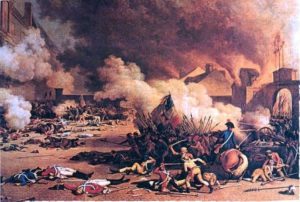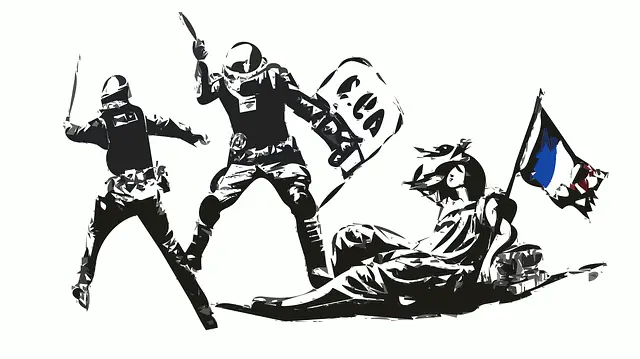
The French Revolution refers to the chain of events that took place in France and resulted in extensive political, economic, and social changes during the period from 1789 to 1799. The French revolution, known for the revolutionary ideas and protests that resulted in the Monarchy, is a vast topic in the pages of world history.
CAUSES OF FRENCH REVOLUTION
The causes of the revolution can be vastly be divided into four – Political, Social, Economic and Intellectual.
POLITICAL CAUSES
France was ruled by The Bourbon Despots, who valued their personal profits and interests over the likes and dislikes of the people. Louis XIV ruled from 1643 to 1715 and Louis XV held the throne from 1715 to 1774. Both of them proved to be bad administrators who under whose rule the country faced wars and economic problems. In 1774, another one from the dynasty, Louis XVI took over the throne. He is known to have worn the crown but was not able to bring bold reforms. Under his rule, France helped America fight the American War of Independence against Britain. This war resulted in making the economic conditions in France even worse. The country was in huge debt by the end of the war in which America gained its freedom.
SOCIAL CAUSES
The social condition of France was very different back then and followed a three estate system of social division. The first estate consisted of the Church (clergy), had about 1 lakh people, and owned 10% of the land. The second state was the nobles, had about 4 lakh people, and owned 25% of the land. The third estate, which was always suppressed by the other two, consisted of people such as artisans, traders, factory workers, and farmers. About 95% of the nation’s population belonged to the third estate. There existed wide disparities among the three estates in terms of the rights. Laws about tax were very unfair to the third estate. The state-imposed zero tax on the first two estates and asked the third estate, which consisted of poor people to bear the burden of taxes. This meant that the third estate had to pay taxes to both the others. There were huge disparities in terms of the lifestyle of people who belonged to the various estates- the first and second estates enjoyed lavish and rich lives when the third estate drowned in poor conditioned.
ECONOMIC CAUSES
France had been under severely bad economic conditions already when Louis XVI came into power. The rising population, increase in debts, crashes in repayment, extreme winters that led to crop failure, and famine led made the economic conditions of the Nation pathetic. The economic causes are said to be the triggering factor of the Revolution.
INTELLECTUAL CAUSES
The 17th and 18th century saw a rise in the social understanding and critical thinking abilities of the people. The period called the ‘Age of Enlightenment’ saw the emergence of philosophers, scientists, and thinkers who had clear opinions and visions on how the state and the government were supposed to work for the people. Some of the famous thinkers were Jean- Jacque Rousseau, Immanuel Kant, and Voltaire. Many of them believed in people’s sovereignty, the separation of church and state, and freedom of expression. They initiated the formation of groups, publishing of newspapers and books and thereby questioning the decisions and responsibilities of the King. Intellectual ideas of different people thus spread to every part of the country, through prints and salon discussions. More and more people eventually joined the intellectual groups. The tension in these various perspectives increased day by day. The debts increased and the country went into a deep economic crisis. All these reasons eventually led to the French Revolution.
Read Industrial Revolution: Causes and Impact
TIMELINE OF THE FRENCH REVOLUTION
In 1789, on continuous deliberation, a super parliament was organized with representatives from all estates. The agenda was to discuss ways to manage the debt crisis. The meeting that was held in The Palace of Versailles was the first of its kind in the preceding 175 years.
However, the meeting ended in disputes over voting rights. The other third estate, which was asked to bear all of the taxes by the other two, stood strongly against this decision. They declared themselves the ‘National Assembly’. Louis XVI, who got immensely angry at their demands and questions for rights, locked the ‘National Assembly’ out of the main hall. The third estate, who had strongly risen intellectually by then, decided to take the famous ‘Tennis Court Oath’ (serment du jeu de paume), deciding not to disperse until a constitution had been made.
As the news of the newly formed National Assembly and their demand spread all over France, peasants started revolting. Riots arose in various parts of the country against the rule of the King. Citizens of the country started getting violent, burnt downland records and awoke themselves to a revolutionary spirit. In response to this breakdown of law and order, Louis XVI asked the cops to assemble in Paris outside Versailles.
Following the riots was the storming of the Bastille, which was a fort that was later converted to a prison that turned out to be a symbol of royal oppression. The rioters rose in rage collectively and stormed the Bastille in an intention to collect gunpowder and weapons that could be put into use against the military of the State. The wave of revolution ran all over the country. This period is known as the period of Great Fear.
The National Assembly ordered the abolition of feudalism and demanded for uniform tax system. The atmosphere of terror and suffocation had made many people from the first and second estates to migrate out of France by the time.
Following the riots, on August 4th, 1789, the country took its first towards transforming into a constitutional monarchy from an absolute monarchy through the ‘Declaration of the Rights of Man and the Citizen’. This document adopted by the assembly contained in its statements of principles of democracy grounded in the ideas of various thinkers and intellectuals of France. The document proclaimed asked for the replacement of absolute monarchical ideas with freedom, equality, and sovereignty. The famous slogan of ‘Liberty, Equality, Fraternity was mentioned in this declaration. However, the declaration had its drawbacks- it classified citizens into two groups, with men enjoying all the rights whereas women and slaves who were considered as passive citizens owning no rights at all.
By the end of 1789, the turmoil had made the economic situation in France worse than before. The rising population struggled to arrange for food and raised their ‘Demand for Bread’.
By 1790, different groups came to the political forefront and started organizing ideas for the Constitution. Different clubs like the Jacobins had different views and opinions on the Constitution that was to be adopted. By 1791, although King Louis tried to escape to Austria, he ended up being caught. People who protested against the Constitutional Assembly’s idea of Constitutional Monarchy ended up facing attacks that resulted in massacres, from the National Guards.
In September 1971, the new constitution prepared by the Assembly came into action and the King was restored as the Head of the State back again. However, due to the conflicting demands from various groups and clubs failed this system within a year of its employment.
In 1792, a war was declared on Austria and Prussia by the legislative assembly, which aimed at thereby spreading revolutionary ideas across other nations of the continent. Meanwhile, the situations in Paris took a strong radical turn when a group led by the extremist Jacobins decided to attack the residence of the royal family in Paris. King Louis XVI was hence arrested on August 10th of 1792. The King was put to death and was executed in January 1793. Immediately after the execution of the King, ‘The War of First Coalition’ took place, in which France was attacked by the coalition of Spain, Dutch, British, Austria, and Prussia.
Later, the third government of the revolution, called ‘The National Convention’ which was dominated by Jacobins came into power. What followed the employment of the new government was one year called ‘The Reign of Terror’. During the period, more than 15000 people, those who were suspected as enemies of the revolutionary ideas were guillotined. The country kept going into severe food shortage and economic crisis over time. At last, people of the country got sick of Jacobins and wanted to expel them from power. Their leader Robespierre was executed in July 1794 and the group was banned.
A new constitution was adopted in 1795, which gave voting rights to one who owned property. Bicameral legislature was devised. The country then fought Italy and Austria under the able leadership of Napoleon, who was then a general in the Army, resulting in the end of the War of First Coalition. Napoleon declared himself “Emperor of France’ in 1804. This shows an interesting fact on the history of the French Revolution. A revolution that had started to overthrow an Emperor had finally ended up in the rule by another emperor! The event marked the end of the French Revolution and the beginning of the Napoleonic era, under which France came to dominate much of the continent.

